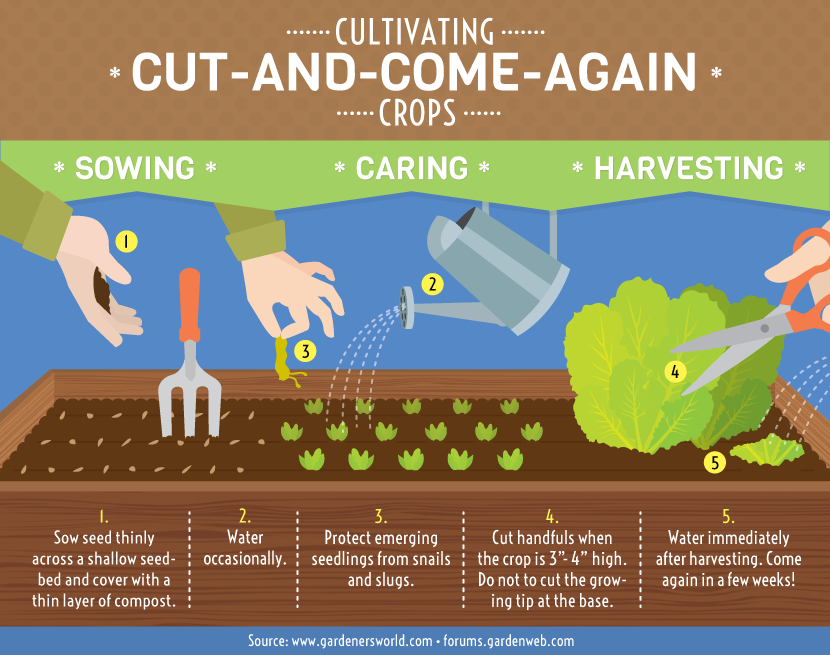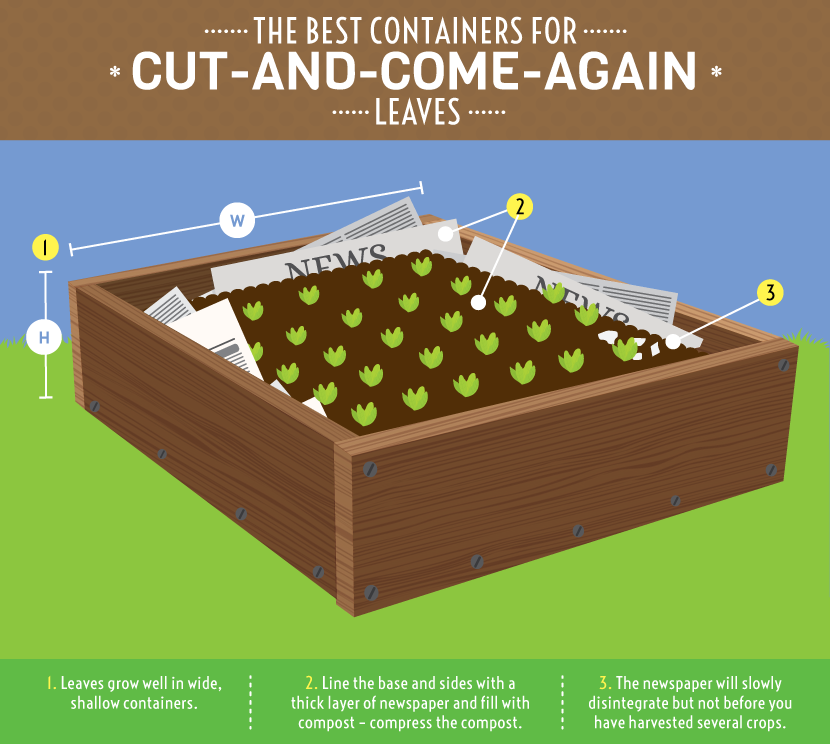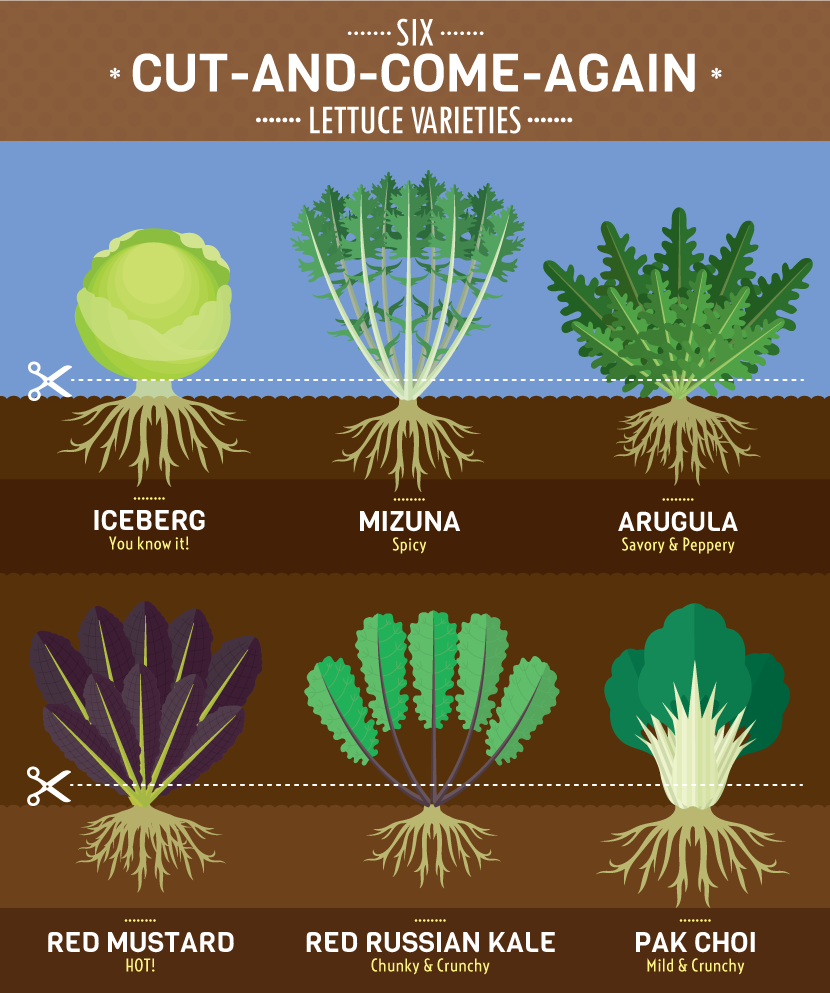Most households make use of the occasional bag of salad leaves. Such bags line supermarket fridge shelves and we eat them by the handful, the various baby leaves they contain providing an easy way of injecting some variety into our green salads. But they are expensive to buy, and these baby leaves happen to be one of the easiest crops you can grow yourself.
In fact, for the price of a bag of salad greens you can buy enough seeds to keep you in leaves for a good couple of months. They are a perfect first crop for a new gardener who has only a window box or a couple of pots¬, and they are extremely productive. Growing a container of baby leaves also means that your salads will always be crispy and fresh, and that you will never again have to put up with slightly sweaty, lightly yellowing salad leaves. Perfect little leaves will be at your beck and call…

One of the most satisfying aspects of growing salad leaves is that they can be grown as a cut-and-come-again crop. This means that once you have sown, grown, and harvested your first crop of leaves, they will grow again with minimal effort from you. It makes this a particularly straightforward way of growing, and space efficient, too.
To start a pot of salad leaves, broadcast sow a handful of seeds across a wide, shallow seed bed. Broadcast sowing means scattering seeds across a wide area, as opposed to drill sowing, which means sowing along a straight line, and it works better here, as it allows for a wide swathe of little plants with plenty of space to grow. Watered regularly and well – the compost volume is fairly minimal and the root system small, so watering needs to be dependable – these plants will soon germinate and start to grow. You will need to protect them from slugs and snails, which will enjoy grazing on their young, tender growth.
A general feed every now and then is a good idea to keep plants growing well, but it is not essential since these plants will be growing for a fairly short time. If you use fresh compost there should be enough feed in the compost itself to keep the plants going for most of their short life.
You can choose when to harvest the leaves, but anything from three to five inches makes for the ideal baby leaf. The harvesting is the crucial part: harvest without due care and your crop will be all “cut” and no “come-again.” Examine your baby plants and you will notice that all of the leaves sprout from the same point, somewhere near the base. This is the growing point. As long as you cut above this your little plants will sprout again.

Once you have a sense of where the growing points are, you can cut whole handfuls without doing any damage. After cutting, take care of your future crop by watering it well. Soon new leaves will start to emerge and will quickly grow to harvestable size. You will get around three harvests out of each tray of plants before they become exhausted and start to grow more slowly, producing tougher leaves. At this point it is a good idea to throw them out and start a new tray.
There are lots of cut-and-come-again seed mixes available that contain a mixture of mild and spicier leaves, different leaf shapes, and a variety of colors, and these are great if you have only one container or are carrying out your first experiments with cut-and-come-agains. However, this is perhaps not the easiest way to grow, as the different varieties can grow at different rates and you can find that some in the same tray are not ready to harvest, while others have grown a little too big for your taste.
If you have the luxury of a little more space, then grow each variety of salad leaf in its own tray. When they are ready to harvest you can create your own mixes of leaves: savory and spicy, mild and crunchy, whatever suits your mood and your food.

There is plenty of fun to be had in growing your own favorite flavors to create mixtures that particularly suit you. For a mild, sweet crunch, grow a few different lettuces, plus pak choi and spinach. Rainbow chard is mild and also beautifully colorful, and is a lovely leaf for injecting a bit of interest into a salad. Likewise, beetroot “Bull’s Blood,” which has an earthy flavor and a dark purple color.
For a spicier mix, choose from all of the oriental mustard greens, plus rocket. Radicchio and endive are great additions for a bitter note, sometimes needed amid a sea of mild butteriness. Many herbs also work beautifully grown in this way and picked tiny, and they make an unusual and delicious addition to a salad, either as small herby notes in a larger salad or – more robustly – as the bulk of it. Try parsley, chervil, fennel, coriander, and basil, any of which can be sown thickly or as part of a mix.
When you have your first tray underway, it is time to think about sowing in succession. After a tray has been cut from three or four times, its plants will be exhausted and it will be time to get rid of it. Rather than waiting until this happens, plan ahead. As you take the first cut of leaves from a tray, sow another. Make it a prerequisite to cutting any salad: first I must sow my next tray. Do this each time a new tray becomes productive and you will soon have a succession of leaves at various stages, ready to harvest at any time.
Baby leaves grown as a cut-and-come-again are one of the handiest crops to have around, and one of the easiest to grow in a small space. They are pretty too, their various colors and shapes forming a tapestry-like effect across a tray or window box. Grow your own and your salads will be plentiful, colorful, tasty, and beautifully fresh…
If you like this story, be sure to share it with your friends and inspire someone you know. Anything becomes possible with just a little inspiration…
H/T: Fix


